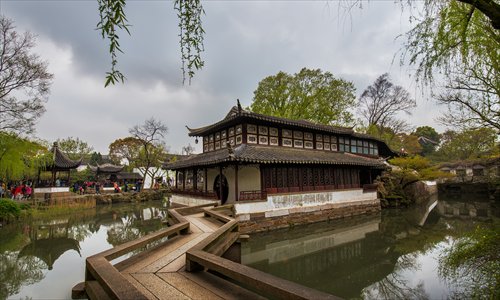
The Humble Administrator's Garden (Photo/GT)
When Marco Polo first visited Suzhou in 1276, he was impressed by the city's rich culture, elegant canals, small waterways and playful stone bridges. He called it "the Venice of the East."
Today if you come to Suzhou in East China's Jiangsu Province, you can still see the beauty he saw 740 years ago. Nothing much has changed. More than 2,500 years old, Suzhou is the oldest city in the Yangtze River region, making a visit there feels like you are traveling back in time.
If you are tired of fast-paced cities and looking for an escape from skyscrapers and loud noises, Suzhou is the place for you. Only 60 miles from Shanghai, it takes only 30 minutes to get there by high-speed rail.
Not just Marco Polo, Chinese people are impressed by its beauty as well. A city of beautiful gardens, it didn't just impress Marco Polo, even Chinese have found themselves standing in amazement. As the Chinese saying goes, "above there is heaven, below there are Suzhou and Hangzhou."
Classical Gardens
Even though Suzhou is not as famous as other destinations such as the famous ancient Chinese capital Xi'an, or Chengdu where you can see cute pandas, many predict it will become China's next hot travel destination.
First things first, Suzhou is famous for its classical gardens, the symbols of the city's wealth. Popular during the 11th-19th centuries, the classical garden design seeks to recreate natural landscapes in miniature and is acknowledged as a masterpiece of the genre, according to UNESCO. Nine out of 50 of the city's classical gardens have been granted UNESCO World Heritage Site status.
These are not Western-style gardens. You will see strangely shaped rocks, disordered landscapes, well-tended bushes and artificial hills. This is the Chinese way of finding the perfect balance between the human world and nature. According to experts, these gardens represent the aesthetic goals and values that you can find in other art forms such as Chinese landscape painting, calligraphy and poetry.
In an article, "What Can We Learn from Chinese Classical Gardens," Professor David Goode points out that these gardens "illustrate a way of life in harmony with nature and the arts that may still have relevance today."
The most famous garden in the city is the Humble Administrator's Garden, the largest classical garden in Suzhou at 51,950 square meters. The greater prosperity in the Ming Dynasty (1368-1644) led to a proliferation of this type of classical garden.
The Humble Administrator's Garden was built by Wang Xianchen, an Imperial Envoy who returned to Suzhou to retire. The space reflects Wang's desire to leave politics behind and adopt a simple life. Paying a $15 admission fee, you can enjoy the divine tranquility and charm of this "Heaven on Earth."
Other famous gardens in Suzhou include the Lingering Garden, which is famous for its corridors and architecture; the Master of Nets Garden, Suzhou's smallest yet probably most impressive garden due to the illusion it gives of being a much bigger space; the Lion Grove Garden, which is famous for its rock sculptures around the lake; and the Couple's Retreat Garden with its unmistakable romantic atmosphere.
Grand canals
Suzhou is also known for its system of waterways and canals. These narrow waterways are among the oldest in the world. Like in Venice, for a real local -experience, take a boat along the winding waterways.
The most magnificent canal is the Grand Canal, also known as the Beijing-Hangzhou Grand Canal.
The name says it all. It is the longest man-made waterway in the world, about 1,770 kilometers long it connects to various river systems along the way. Like the classical gardens, the Grand Canal is also a UNESCO World Heritage Site. With a history stretching back more than 2,000 years, there are more than 58 historical sites along its course.
With its rich cultural heritage and laid-back atmosphere, Suzhou is a city where you can experience both urban and rural China. After dinner, the locals like taking slow walks along the river. If you look carefully, you might discover some delightful small gardens hidden behind the walls of the crowded neighborhoods.


















































